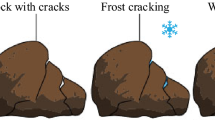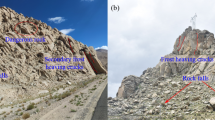Abstract
In cold regions, rock fractures can expand under the force of frost heave pressure, potentially triggering severe geological catastrophes such as collapses and landslides on rock slopes. Nevertheless, a comprehensive study of the evolution patterns and causes of frost heave pressure within rock fractures is currently lacking. To address this gap, this paper focuses on single-cracked sandstone and identifies four distinct types of frost heave pressure curves by conducting monitoring tests under various conditions. Each type of curve was thoroughly analyzed to understand its evolution and the underlying causes. It was found that the rupture and drop type curve can be segmented into five stages: incubation, eruption, drop, equilibrium, and dissipation. The drop stage is predominantly attributed to the fracturing of the crack influenced by frost heave pressure. Compared with the rupture and drop type curve, the stable type curve, where the crack does not expand during the freeze–thaw cycle, lacks a drop stage. Furthermore, samples displaying a stable descent type curve possess a higher freezing temperature, causing a noticeable delay in the emergence of their frost heave pressure. This curve, when compared with the stable type, shows a faster reduction in frost heave pressure during the equilibrium stage. For the secondary frost heave type curve, secondary frost heave emerges within the rock fracture at the onset of thawing, with the rupture of ice proving critical to this phenomenon. The frost heave pressure distributed along the crack surfaces of the four types of curves displays a lack of uniformity. This unevenness is observed to correlate with the inconsistent growth of ice according to its self-purification principle. Finally, based on the experimental results, a novel criterion for frost heave pressure and rock fracture cracking is proposed.
Highlights
-
Four distinct frost heave pressure curves are obtained, and the underlying causes of each are examined.
-
The uneven growth of ice causes non-uniform frost heave pressure distribution within the fracture.
-
Ice rupture is pivotal to the formation of secondary frost heave.
-
A novel criterion for frost heave pressure and rock fracture cracking is proposed.





















Similar content being viewed by others
Data Availability
Data will be available on request.
References
Beier N, Sego D, Donahue R, Biggar K (2007) Laboratory investigation on freeze separation of saline mine waste water. Cold Reg Sci Technol 48(3):239–247
Bost M, Pouya A (2017) Stress generated by the freeze–thaw process in open cracks of rock walls: empirical model for tight limestone. Bull Eng Geol Environ 76(4):1491–1505
Cao R et al (2020) Effects of cyclic freeze–thaw treatments on the fracture characteristics of sandstone under different fracture modes: laboratory testing. Theor Appl Fract Mech 109:102738
Cao C, Feng J, Zhang Z, Lu L, Tao Z (2022) Characteristics and mechanism of dump landslides under compound loads based on physical model test. Bull Eng Geol Environ 81(9):350
Cui P et al (2022) Scientific challenges in disaster risk reduction for the Sichuan–Tibet railway. Eng Geol 309:106837
Davidson GP, Nye JF (1985) A photoelastic study of ice pressure in rock cracks. Cold Reg Sci Technol 11(2):141–153
Deng Z, Zhan X, Zeng W, Yang S, Wu J (2021) A degradation model of mode-I fracture toughness of rock under freeze–thaw cycles. Theor Appl Fract Mech 115:103073
Deprez M, de Kock T, de Schutter G, Cnudde V (2020) A review on freeze-thaw action and weathering of rocks. Earth Sci Rev 203:103143
Draebing D, Mayer T (2021) Topographic and geologic controls on frost cracking in Alpine rockwalls. J Geophys Res Earth Surf 126(6):e2021JF006163
Freire-Lista DM, Fort R, Varas-Muriel MJ (2015) Freeze–thaw fracturing in building granites. Cold Reg Sci Technol 113:40–51
Hailiang J, Siqi Z, Shun D, Ting W, Yuanhong D, Xianjun T (2022) Study on the evolution and influencing factors of frost heaving force of water-bearing cracks during freezing-thawing process. Chin J Rock Mech Eng 41:1832–1845
Huang S, Wang J, Liu Y, Tian Q, Cai C (2023) Experimental investigation on crack coalescence and strength loss of rock-like materials containing two parallel water-filled flaws under freeze–thaw. Theor Appl Fract Mech 123:103669
Jamshidi A, Nikudel MR, Khamehchiyan M (2013) Predicting the long-term durability of building stones against freeze–thaw using a decay function model. Cold Reg Sci Technol 92:29–36
Jia H, Leith K, Krautblatter M (2017) Path-dependent frost-wedging experiments in fractured, low-permeability granite. Permafr Periglac Process 28(4):698–709
John M et al (2018) Purity and mechanical strength of naturally frozen ice in wastewater basins. Water Res 145:418–428
Kang Y, Liu Q, Liu X, Huang S (2014) Theoretical and numerical studies of crack initiation and propagation in rock masses under freezing pressure and far-field stress. J Rock Mech Geotech Eng 6(5):466–476
Krautblatter M, Funk D, Günzel FK (2013) Why permafrost rocks become unstable: a rock–ice-mechanical model in time and space. Earth Surf Process Land 38(8):876–887
Lin H, Lei D, Zhang C, Wang Y, Zhao Y (2020) Deterioration of non-persistent rock joints: a focus on impact of freeze–thaw cycles. Int J Rock Mech Min Sci 135:104515
Lv Z, Xia C, Li Q, Si Z (2019) Empirical frost heave model for saturated rock under uniform and unidirectional freezing conditions. Rock Mech Rock Eng 52(3):955–963
Maji V, Murton JB (2020) Experimental observations that simulated active-layer deepening drives deeper rock fracture. Permafr Periglac Process 31(2):296–310
Matsuoka N (2001) Direct observation of frost wedging in alpine bedrock. Earth Surf Process Land 26(6):601–614
Matsuoka N (2019) A multi-method monitoring of timing, magnitude and origin of rockfall activity in the Japanese Alps. Geomorphology 336:65–76
Mousavi SZS, Tavakoli H, Moarefvand P, Rezaei M (2019) Assessing the effect of freezing-thawing cycles on the results of the triaxial compressive strength test for calc-schist rock. Int J Rock Mech Min Sci 123:104090
Murton JB, Peterson R, Ozouf J (2006) Bedrock fracture by ice segregation in cold regions. Science 314(5802):1127–1129
Regmi D, Watanabe T (2009) Rockfall activity in the Kangchenjunga area, Nepal Himalaya. Permafr Periglac Process 20(4):390–398
Romanovsky VE, Osterkamp TE (2000) Effects of unfrozen water on heat and mass transport processes in the active layer and permafrost. Permafr Periglac Process 11(3):219–239
Scherler M, Hauck C, Hoelzle M, Stähli M, Völksch I (2010) Meltwater infiltration into the frozen active layer at an Alpine permafrost site. Permafr Periglac Process 21(4):325–334
Song Z, Wang Y, Konietzky H, Cai X (2021) Mechanical behavior of marble exposed to freeze–thaw-fatigue loading. Int J Rock Mech Min Sci 138:104648
Song Z, Yang Z, Song F, Wu Y, Konietzky H (2022) Mechanical responses of freeze-thaw treated natural stone masonry subject to compressive variable amplitude fatigue loading: insights from stiffness loss and constitutive characterization. Constr Build Mater 350:128908
Sun L, Tao S, Liu Q (2023) Frost crack propagation and interaction in fissured rocks subjected to freeze–thaw cycles: experimental and numerical studies. Rock Mech Rock Eng 56(2):1077–1097
Tada H, Paris PC, Irwin GR (1973) The stress analysis of cracks handbook. Del Research Corp
Tan X et al (2018) A unified model for frost heave pressure in the rock with a penny-shaped fracture during freezing. Cold Reg Sci Technol 153:1–9
Tang X et al (2022) The propagation and interaction of cracks under freeze–thaw cycling in rock-like material. Int J Rock Mech Min Sci 154:105112
Tao S, Tang X, Rutqvist J, Liu Q, Hu M (2021) The influence of stress anisotropy and stress shadow on frost cracking in rock. Comput Geotech 133:103967
Thomas MT (1987) Conditions for crack propagation by frost wedging. Geo Sci World 99(1):94–102
Timoshenko (1970) Theory of elasticity. McGraw-Hill Book Co.
Wang Y, Han JQ, Li CH (2020) Acoustic emission and CT investigation on fracture evolution of granite containing two flaws subjected to freeze–thaw and cyclic uniaxial increasing-amplitude loading conditions. Constr Build Mater 260:119769
Wei M, Dai F, Liu Y, Jiang R (2023) A fracture model for assessing tensile mode crack growth resistance of rocks. J Rock Mech Geotech Eng 15(2):395–411
Wu Y, Wang Y, Haim W, He S, Li X (2020) Fracture of rocks in the mountains of Southeast Tibet under hydrothermal conditions at different elevations. Bull Eng Geol Env 79(8):4291–4308
Wu Y, Li X, Zhu L (2021) Fracture mechanism of rock collapse in the freeze–thaw zone of the eastern Sichuan–Tibet mountains under seasonal fluctuating combinations of water and heat. Nat Hazards 108(2):2309–2333
Yan J et al (2023) A new framework for geometrical investigation and stability analysis of high-position concealed dangerous rock blocks. Acta Geotech 18(3):1269–1287
Zhang M, Pei W, Zhang X, Lu J (2015) Lateral thermal disturbance of embankments in the permafrost regions of the Qinghai–Tibet engineering corridor. Nat Hazards 78(3):2121–2142
Zhang T et al (2023) Characteristics and dynamic analysis of the February 2021 long-runout disaster chain triggered by massive rock and ice avalanche at Chamoli, Indian Himalaya. J Rock Mech Geotech Eng 15(2):296–308
Zhao G et al (2023a) Anisotropic mechanical behavior of ultra-deep shale under high in-situ stress, a case study in the Luzhou block of the southern Sichuan Basin, China. Int J Rock Mech Min Sci 170:105536
Zhao G et al (2023b) Experimental study on mechanical, brittleness, and fracture behavior of deep shales subjected to fracturing fluid–shale interactions at reservoir temperature and in-situ stress conditions. Rock Mech Rock Eng 57(1):27–44
Zhelnin M et al (2022) Coupled thermo-hydro-mechanical modeling of frost heave and water migration during artificial freezing of soils for mineshaft sinking. J Rock Mech Geotech Eng 14(2):537–559
Zhou J, Qin C (2020) A novel procedure for 3D slope stability analysis: lower bound limit analysis coupled with block element method. Bull Eng Geol Env 79(4):1815–1829
Zhou Y et al (2021) Numerical simulation of fracture propagation in freezing rocks using the extended finite element method (XFEM). Int J Rock Mech Min Sci 148:104963
Zhou JW, Fan G, Chen Q, Yang XG (2022) Comprehensive analyses of initiation and failure mechanisms of the 2017 Xinmo catastrophic rockslide. J Mt Sci 19(6):1525–1540
Acknowledgements
This study received funding from the project (No. 2018YFC0808401 and No. 2018YFC0808402) supported by the National Key Research and Development Program of China.
Funding
This work is supported by the the National Key Research and Development Program of China (2018YFC0808401, 2018YFC0808402).
Author information
Authors and Affiliations
Corresponding author
Ethics declarations
Conflict of interest
The authors declare that they have no known competing financial interests or personal relationships that could have appeared to influence the work reported in this paper.
Additional information
Publisher's Note
Springer Nature remains neutral with regard to jurisdictional claims in published maps and institutional affiliations.
Rights and permissions
Springer Nature or its licensor (e.g. a society or other partner) holds exclusive rights to this article under a publishing agreement with the author(s) or other rightsholder(s); author self-archiving of the accepted manuscript version of this article is solely governed by the terms of such publishing agreement and applicable law.
About this article
Cite this article
Wang, G., Zhang, J., Tian, Z. et al. Decoding Rock Fracture Behavior: A Classification of Frost Heave Pressure Evolution in Freeze–Thaw Process. Rock Mech Rock Eng (2024). https://doi.org/10.1007/s00603-024-03821-w
Received:
Accepted:
Published:
DOI: https://doi.org/10.1007/s00603-024-03821-w




